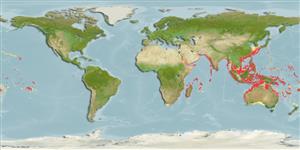>
Elopiformes (Tarpons and tenpounders) >
Megalopidae (Tarpons)
Etymology: Megalops: Greek, megas, megalos = great + Greek, ops = appearance (Ref. 45335).
Environment: milieu / climate zone / depth range / distribution range
Ecologia
marinhas; Água doce; estuarina bentopelágico; anfídromo; intervalo de profundidade 50 - ? m (Ref. 2847). Tropical; 34°N - 37°S, 16°E - 130°W
Indo-Pacific: Persian Gulf (Ref. 68964), Red Sea and Natal, South Africa (Ref. 3969) to the Society Islands, north to southern Korea, south to the Arafura Sea (Ref. 9819) and New South Wales. Restricted to high islands (Palau, Caroline and Mariana islands) in Micronesia. Reported as far inland as the lower Shire in Malawi and the Save-Runde junction in Zimbabwe (Ref. 7248, 52193). Widespread in the Lower Zambezi River channels up to Marromeu and in the Micelo River up to Malingapanzi (Ref. 39494). South China Sea, Taiwan Strait, and East China Sea(Ref.33302).
Comprimento de primeira maturação / Tamanho / Peso / Idade
Maturity: Lm ?, range 25 - ? cm
Max length : 150 cm TL macho/indeterminado; (Ref. 1479); common length : 30.0 cm SL macho/indeterminado; (Ref. 7017); common length :45.5 cm SL (female); peso máx. publicado: 18.0 kg (Ref. 13337); idade máx. registrada: 44 anos (Ref. 72487)
Espinhos dorsais (total): 0; Raios dorsais (total): 16-21; Espinhos anais 0; Raios anais : 23 - 31.
Obligate air-breathing (Ref. 126274); Adults are generally found at sea, but young inhabit river mouths, inner bays, and mangrove forests. In freshwater, they occur in rivers, lagoons, lakes, and swampy backwaters (Ref. 2847, 44894). Tolerate a wide pH range (5.2-9.1) (Ref. 44894) and salinities from 0 to 100. Mainly diurnal (Ref. 7017). Predaceous, feeding mainly on fishes and crustaceans (Ref. 5213). Breed offshore, possibly throughout the year. Larvae are transparent and resemble larval eels (Ref. 13337), but with a forked tail (Ref. 167). Juveniles commonly enter freshwater (Ref. 44894, 48635) in clear or turbid water (Ref. 44894). Known to breath air, rising regularly to the surface to do so. Cultured in ponds, the fry being sourced from the coasts (Ref. 7050). Popular angling fish (Ref. 3969). Edible but not esteemed (Ref. 3969). Caught by gill nets, seines, and trawls, and by hook-and-line; marketed fresh and dried salted (Ref. 10982).
Ciclo de vida ou comportamento de acasalamento
Maturidade | Reprodução | Desova | Ovos | Fecundidade | Larvas
Whitehead, P.J.P., 1984. Megalopidae. In W. Fischer and G. Bianchi (eds.) FAO species identification sheets for fishery purposes. Western Indian Ocean fishing area 51. Vol. 3. [pag. var.]. FAO, Rome. (Ref. 3463)
Status na Lista Vermelha da UICN (Ref. 130435)
Ameaça para os humanos
Harmless
Uso pelos humanos
Pescarias: pouco comercial; Aquacultura: espécies comerciais; peixe esportivo: sim
Ferramentas
Relatórios especiais
Baixar XML
Fontes da internet
Estimates based on models
Preferred temperature (Ref.
123201): 19.8 - 27.6, mean 24.4 °C (based on 501 cells).
Índice de diversidade filogenética (Ref.
82804): PD
50 = 1.0020 [Uniqueness, from 0.5 = low to 2.0 = high].
Bayesian length-weight: a=0.00741 (0.00532 - 0.01033), b=3.07 (2.97 - 3.17), in cm total length, based on LWR estimates for this species (Ref.
93245).
Nível Trófico (Ref.
69278): 3.5 ±0.1 se; based on diet studies.
Resiliência (Ref.
120179): médio(a), tempo mínimo de duplicação da população 1,4 - 4,4 anos (Assuming tm<=4).
Prior r = 0.57, 95% CL = 0.37 - 0.85, Based on 2 stock assessments.
Fishing Vulnerability (Ref.
59153): Very high vulnerability (90 of 100).
Climate Vulnerability (Ref.
125649): High to very high vulnerability (75 of 100).
Nutrients (Ref.
124155): Calcium = 44.8 [26.3, 77.6] mg/100g; Iron = 0.672 [0.410, 1.048] mg/100g; Protein = 17.1 [14.3, 19.7] %; Omega3 = 0.217 [0.122, 0.396] g/100g; Selenium = 71.1 [41.2, 135.1] μg/100g; VitaminA = 15 [6, 33] μg/100g; Zinc = 1.06 [0.78, 1.46] mg/100g (wet weight);
